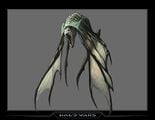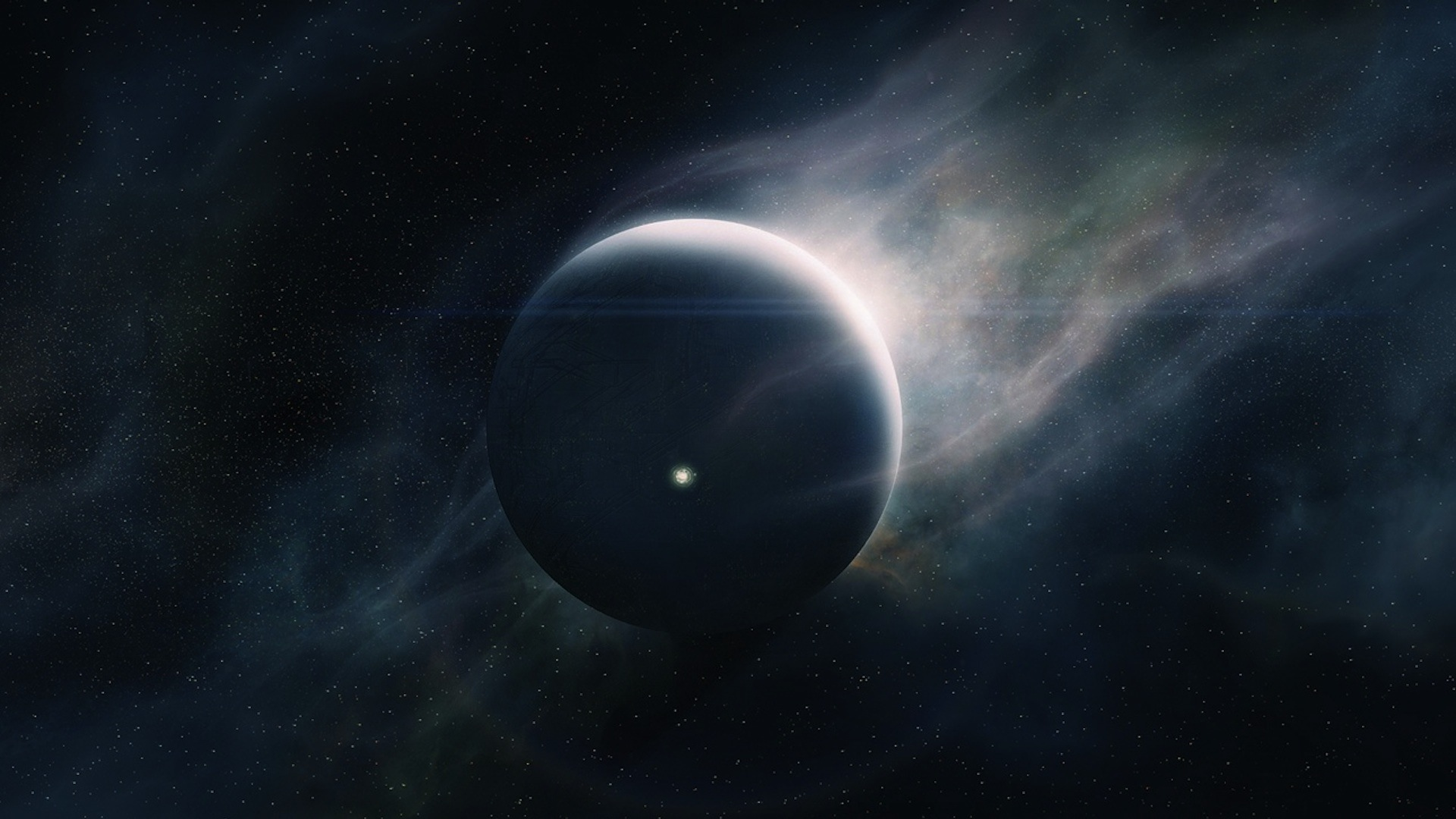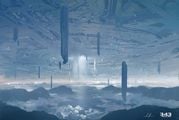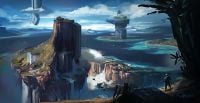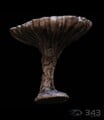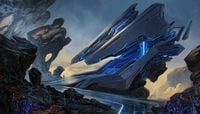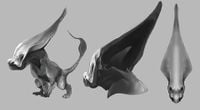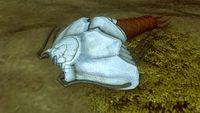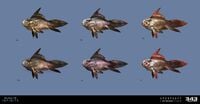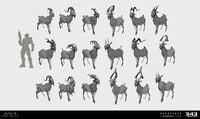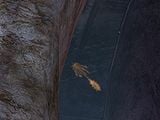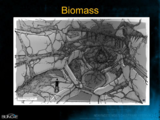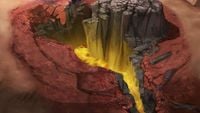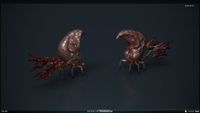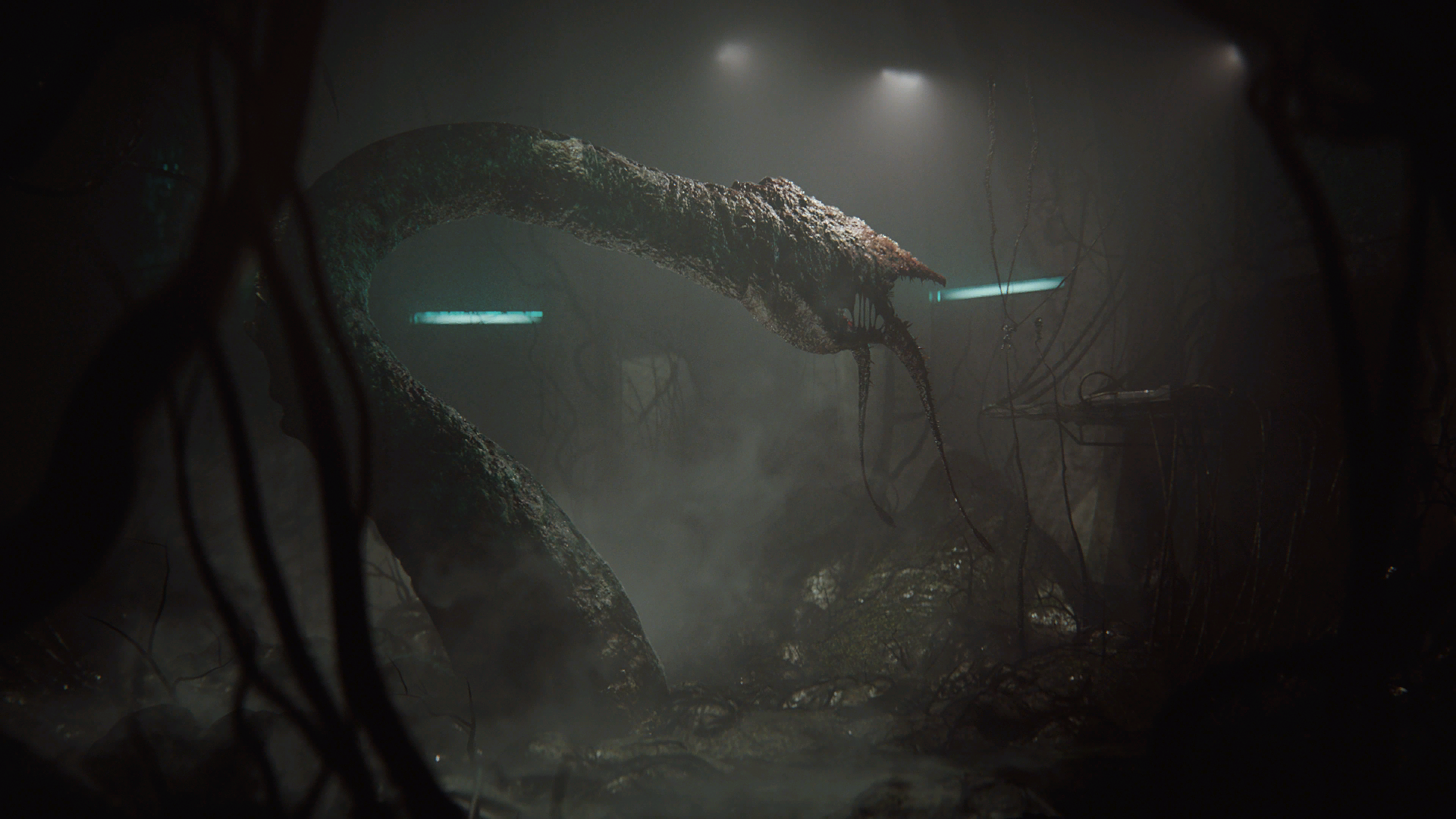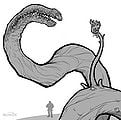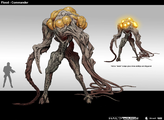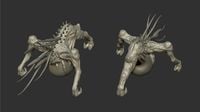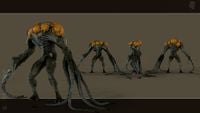The Wildlife of Halo
From Halopedia, the Halo wiki
The following is an overview for a hypothetical Wildlife of Halo field guide, akin to other published art/lore books from Microsoft such as Halo: Warfleet or the Halo Encyclopedia. Its aim is to showcase the art and science of the Halo universe.
This is a work-in-progress document that may not be complete as of this reading.
Overview
This sandbox represents the proposed text and artwork for The Wildlife of Halo, as well as the general structure of the book and how it corresponds to the story of humanity's exploration of the galaxy within Halo lore. The intent is to tell the narrative of humanity's expansion from Earth throughout the Orion Arm from a scientific perspective, including the ecological mysteries that emerged on human colony worlds (foreshadowing later discoveries), the revelations brought about by the knowledge of Covenant space, and finally the mysteries of the Forerunners and their various installations.
The information presented here does not accord with Halopedia's standards for accurate lorekeeping, nor does it intend to. Instead of presenting only hard data from established sources, this document also includes elements of original lore, as though the text here were to be published as a reference book for fans to pore over and learn from. Original lore that is not part of official Halo canon may appear with explanatory notes,[Note 1] though not in all instances.
When reading the guide in this format, keep in mind that each section or sub-section as formatted here on the wiki implies a page break. Full-size images represent artwork that would appear at the start of a new "chapter" within the book, typically a two-page spread for maximum visual impact, introducing a new location, which subsequent pages explore in detail. Images presented as part of a gallery would--in the published book--be formatted according to the needs of the page and the text they accompany, but that design is not included here.
The book currently sits at a proposed 133 pages.
"Empty" gallery images indicate an opportunity for Halo Studios to commission new artwork from proven artists. In-game screenshots are likewise used as placeholders, with 2D conceptual art or sketches preferred for the final book.
This is particularly exciting as the artist has the chance to contribute lore conceived during the composition of the images towards official canon, fleshing out unexplored corners of the Halo universe. Some sections of the book will also provide a unique opportunity to collaborate with real astronomers and scientists, especially where the Halo universe overlaps with real-world data. Some examples of these include Holocene ecological trends, Solar System colonies, terraforming processes, and colonies that correspond to real exoplanets. These opportunities for multidisciplinary collaboration will help elevate the art and science at the heart of this book.
Work on this page began on October 18th, 2024. This is a work-in-progress document that may not be complete as of this reading.
Introduction
In-universe introduction to the book and its xenobiologist author/framing device. Ellen Anders presents the most established xenobiologist character from which to frame the narrative, but an original civilian character is preferred, as this can be used to establish how information about the Forerunners/Flood is shared or sequestered between the UNSC and civilian groups.
Human Sphere
Prehistoric Earth
Emerging from prehistoric Africa, our species was one of many hominids that evolved on Earth. This period in our evolutionary history is a great mystery to scientists, with debate about what caused such a variety of hominid forms to diversify around this time, only to shortly thereafter be overtaken by a single dominant species. Homo sapiens began as a tribal species worshipping totemic animal spirits, but with an intense proclivity for exploration and adventure. This lust for the unknown led us to conquer the planet, spreading to every corner of the globe, speaking many languages, interpreting the universe through many religions, constructing great works of art. We conquered fire, tamed electricity, built great cities, learned the secrets of the universe...
Earth
...And our civilization was mighty. But this came at a cost. Overpopulation was a serious concern as more and more people crowded into less and less land, concentrating resources in cities and sucking dry the natural world. Wars between great nations swept the land, ravaging all in their wake. As our species increasingly relied on and expanded its technology, the climate itself was changed by the engines of industry. Coastlines were altered by rising sea levels. Ecosystems died out. And then, as the artificially-intelligent minds we had built sought solutions to our problems, one came... in the form of the Shaw-Fujikawa Translight Engine.
Climate and the Holocene Extinction
Humanity has had a long history of ecological exploitation, increasing in scope as our technological capacity to alter the world grew. With humanity's spread across the globe, naturally threatened and at-risk animal populations--such as those limited to singular, isolated environments--were the first to have extinction at our hands. Organisms like the dodo bird, the great auk, the carrier pigeon, and certain cetacean populations were wiped out in the 18th and 19th centuries due to overhunting. During the Industrial Revolution, the means of mass-extermination increased. More and more populations began to drop off the face of the Earth at humanity's hands. Increased environmental population came hand in hand with the combustion engine and the increased concentration of toxic compound into factory environments. Organisms that depended on healthy bio stability in the affected areas began to suffer slow population decline. Beginning with the advent of inter-continental air travel, the introduction of invasive species across all global ecosystems meant native organisms were out-competed by more efficient organisms that they didn't evolve to compete with. By the 24th century, scientists had noted that cross-contamination of invasive organisms had become the greatest threat to biodiversity on Earth. Many previously remote ecosystems have homogenized, incorporating foreign organisms into local ecosystems. As such, life forms that were previously only found in one environ can often be found across the entire globe. In the current day of the 26th century, scientists are beginning to acknowledge that this process has been occurring--albeit at a slower rate--on our extrasolar colonies. Today, many species that once flourished in the wild can only be found in zoos and specialized wildlife reserves.
Rainforest Wars and famine
Glassing of Voi and loss of East African megafauna
New Phoenix Incident
FTL
Shaw-Fujikawa Translight Manifold
Our species was suddenly able to leave the claustrophobic confines of the Earth, to spread our wings and stretch to fill an infinite horizon.
Terraforming
- "Atmospheric processors, orbital mirror arrays, and the introduction of genetically engineered microorganisms can nudge a less-than-hospitable planet toward human sustainability over a period of decades or centuries, but they do not remake worlds from scratch."
- "Venus was a long-shot terraforming project whose failure was so colossal and complete that it continues to be a cautionary tale for initiatives seeking to transform marginal worlds for human habitation. There are no permanent habitats on the extraordinarily hostile surface, with derelict orbital platforms existing as solemn reminders."
- "Modification and hybridization of crops and animals for specific planetary environments was key to the success of almost every colony. The field has enjoyed significant growth since the Domus Diaspora. with each colony world providing a wealth of new species to study and new genetic sequences to decode."
- "The limited use of cloning for livestock management has been commonplace for centuries.
- Halo Encyclopedia (2022)"
The field of exobiology flourished, studying not just the potential evolution of life in our solar system, but expanding to study the effects of new planetary bodies on terrestrial organisms that were essential parts of the terraforming and colonization process.
Mars
Venus
Full page atmospheric view of Venus, with orbital monitoring stations, terraforming satellites, and the debris of abandoned research stations circling a slightly greener surface than we know today.
Europa and Xenobiology
This section could largely be a showcase to real-world research into Europa as an abode of life as well as tribute to Arthur C. Clarke's vision of Europa in the Space Odyssey series.
Cryonics
Uses and applications for human transport, agricultural products and livestock.
Early Colonies
- Visual needed
Juneou - colonized 2330
- Visual needed
Titus - colonized 2355
Reach
But when we got to Epsilon Eridani II, we found something strange. The environment was vaguely familiar, like the same landscape interpreted by a different artist. Much of the flora and fauna of the planet--which came to be known as Reach--were incredibly similar to their Earth counterparts (albeit adapted for more rugged terrain and marginally higher gravity), and some species were even identical! Many plants common to the Pacific Northwest region of Earth were found in abundance on Reach, including Western hemlock and Douglas firs. But Reach also had its fair share of unique species, like the Gúta, Spadehorn, and Moa, all encountered early on in Reach's colonization by predominantly Hungarian settlers.
Although Reach would take decades for terraformers to tame, the wealth of data it brought to scientists meant millions of years worth of new information to gather. To speak nothing of its riches in astronomical and geological data, Reach had also solved for biologists the age-old Sample Size Problem: the wealth of data that we had to work with about the evolution of life in the universe totaled not one, but two... and what we learned completely rewrote evolutionary taxonomy. Xenobiology was no longer a theoretical field.
Xenobiologists were relieved to see that the native organisms of Reach could still be broadly classed according to traditional phylogeny: Reach indeed possessed plants, animals, fungi, and abundant microorganisms. The presence of near-identical terrestrial species posed a mystery that invited many theories, further compounded by genetic testing which confirmed that the Douglas fir of Reach was, in fact, the same Douglas fir of Earth. Many proponents of the panspermia theory claimed this was proof of exchanged material between star systems. Others claimed the organisms must have been transported to Earth by previous visitors, and that this was proof of intelligent alien life that predated humanity. Others still claimed that the organisms indeed arose natively on Reach, independent of any exchange with Earth, and our understanding of genetics would need to be entirely rewritten.
Either way, going forward, xenobiologists knew that it was possible to find strange, alien phylums on new planets, as well as all-too-familiar species that seemed like they could have been brought straight from Earth, alongside species that were brought from Earth as part of the terraforming process. The broad terms which scientists agreed to use going forward were:
- Terrestrial: Native to Earth and brought as part of the colonization process--traditional examples include beasts of burden (like horses) and livestock (such as cattle, pigs, and chickens)
- Exo-organism: Species that were identical to Earth-native species, but appeared to be part of the natural evolutionary history of the planet (or transplanted so long ago as to be part of the evolutionary history). Encompasses exoflora and exofauna.
- Xeno-organism: Completely new taxonomy with few analogues to terrestrial life. Encompasses xenoflora and xenofauna.[Note 2]
Within these the general phylogeny of animal, plant, fungi, or micro-organism still held, though part of a different tree of life from that studied for centuries on Earth.
The phenomena of exo-organisms remained one of the most incontrovertible pieces of evidence for the existence of extrasolar intelligent life prior to 2525. While the existence of out-of-place biota has largely passed into the realm of mundane everyday knowledge as of the 26th century, it became a cultural sensation within scientific communities at the time of its discovery and remained at the forefront of public discourse for over a century.[Note 3]
Exo-organisms
Exoflora
- Visual needed
Douglas fir
Exofauna
- Visual needed
Wolf
Xeno-organisms
Xenofauna
Spadehorn
Moa
- VTHU
Gúta
- Visual needed
Reavian Redcrest
- Visual needed
Cherot
- Visual needed
Guper
- Visual needed
Kropey
Eridani System
But Eridani II was not the only candidate in the Eridani System. Once a foothold was established on Reach, the other habitable planets in the system were scouted.
Beta Gabriel
Water world eventually valued as an in-system planetary nature preserve, serving as a popular holiday destination for the wealthy, but also a paradise for scientists of all types. It was on Beta Gabriel that the Paelosur and Nightmare Eel were discovered.
Xenofauna
- Visual needed
Krill-like creature
- Visual needed
Three-meter crustacean
Tribute
Circumstance
Inner Colonies
Sigma Octanus IV
Luyten
- Visual needed
Colonized 2387
- Visual needed
Xenofaun - Apocritii
- Visual needed
Xenofauna - Nightgyr
- Visual needed
Xenofauna - Blood Mot
- Visual needed
Xenofauna - Thumb Bird
Oban
Xeno-organisms
Xenoflora
Alluvion
Alluvion established the borderline with the Outer Colonies. It was on Alluvion that scientists discovered the same xeno-organisms they had discovered on Beta Gabriel, in the same system as Reach. There was no explanation for the presence of these creatures on planets separated by light years, unless they were evidence that previous visitors had transported them from world to world. It shed a new light on the presence of Earth-analogous exo-organisms on extrasolar worlds, and reaffirmed for science that it was not just the Earth environment that had been distributed through some means across multiple planets.
Xenofauna
Outer Colonies
New Carthage
- Visual needed
Xenofauna - Great Red Shark
Levosia
- Visual needed
Colonized 2414
Endymion
- Visual needed
Colonized 2420
Far Isle
- Visual needed
Colonized 2421
Arcadia
- Visual needed
Xenofauna - Drymander
Circinius IV
Pacific Northwest Planet[Note 4]
Exo-organisms
Exoflora
Exofauna
Cascade The "crown jewel" of the Outer Colonies.
Carrow
Draco III
- Visual needed
Xenofauna - Bat-shaped leech
- Visual needed
Xenofauna - Ice shark
- Visual needed
Xenofauna - Naeori
Gao
- Visual needed
Colonized 2439
- Visual needed
Xenofauna - Gray Apes
- Visual needed
Xenofauna - Saurio
- Visual needed
Xenofauna - Jungaloon
- Visual needed
Xenofauna - Idjom
- Visual needed
Xenofauna - Frilled Salamander
- Visual needed
Xenofauna - Ribbon-Snake
- Visual needed
Xenofauna - No-Shell Snail
- Visual needed
Xenofauna - Speckled Jungle Dragon
- Visual needed
Xenofauna - Glowfish
Terceira
- Visual needed
Xenofauna - Giant Crocodile
Biko
- Visual needed
Colonized 2440
Andesia
- Visual needed
Colonized 2450
Venezia
Netherop
- Visual needed
Colonized 2450
- Visual needed
Xenoflora - Sail Plants
- Visual needed
Xenoflora - Vase Bushes
Madrigal
Talitsa
Dwarka
- Visual needed
Colonized 2460
- Visual needed
Xenofauna - Dwarkan Ghost Squirrel
- Visual needed
Xenofauna - Dwarkan Centipede
- Visual needed
Xenofauna - Dwarkan Beetles
Sedra
- Visual needed
Xenoflora - Sedran Red Fruit
- Visual needed
Exofauna - Mourning Warbler
- Visual needed
Xeofauna - White Sturgeon
Coral
- Visual needed
Colonized 2470
Roost
- Visual needed
Colonized 2490
- Visual needed
Xenofauna - Tropical Fish
Concord
- Visual needed
Exoflora - Juniper
- Visual needed
Exoflora - Sage
Onyx
Colonized 2491
Exo-organisms
Exoflora
Harvest
Colonized 2468
Terrestrial organisms
- Visual needed
Bats
- Visual needed
Gophers
- Visual needed
Honeybees
- Visual needed
Starlings
Exo-organisms
Exofauna
Xeno-organisms
Xenofauna
Glasslands
First Contact: Harvest
Ecological Catastrophe
- "The aliens had rained monsoons of hot plasma down on hundreds of worlds, burning soil and melting bedrock, boiling oceans and filling the air with superheated vapor. Any creature that had escaped instant incineration had suffocated on superheated smoke, or seared away its feet. Fleeing over molten ground, or emerged from hiding to eventually starve while wandering barren expanses of ash-impregnated lechatelierite."
- "The glasslands still showed orange because lechatelierite cooled from the top down, its surface solidifying into a vitreous blanket that kept heat from radiating into the air. The ground beneath could stay molten for a year, and remain hot to the touch for a decade. And the beach existed because much of the liquid that had been vaporized during the Covenant’s plasma bombardment had not yet returned to the oceans. Most of the planet’s water continued to hang in the atmosphere in vast banks of fog and clouds, or to lie trapped on the glass in giant lakes and ash bogs.
- Halo: Shadows of Reach"
Crows have survived on glassed planets.
Post-War Colonies
Colonies discovered in the course of military actions during the Human-Covenant War, or after.
Partition
Draetheus V
Eudemon
Erebus VII
Exoflora
- Visual needed
Juniper
Xenoflora
Xenofauna
Covenant Sphere
Sanghelios
Xeno-organisms
Xenoflora
- Visual needed
G'lul'g Tree
- Visual needed
Irukan
- Visual needed
Kafel
Xenofauna
- Visual needed
Doarmir
- Visual needed
Electric Kesh
- Visual needed
Keifra
- Visual needed
Nishum
- Visual needed
Quillick
- Visual needed
Snap-Tails
- Visual needed
Thremaleon
- Visual needed
Velithra
Moons
Sangheili Colonies
One of the things the Sangheili revealed to humanity was that during their period of early interstellar colonization, they had likewise discovered familiar organisms on nearby worlds. As their Empire grew, it became clear the planets around Sanghelios had Sanghelios-like ecosystems, much as near-Earth planets featured Earth-like ecosystems.
Rahnelo
Heian
Feldokra
Saepon'kal
Kostroda
Zoist
Strilun IV
Janjur Qom
Te
Palamok
Eayn
Other than Sangheilios--of which we possess extensive information thanks to diplomatic ties with the Sangheili--Eayn is probably the most directly researched and studied Covenant planet, thanks largely to its location within the bounds of humanity's Outer Colonies.
When humanity first encountered the Kig-Yar, they were the "Jackals" of the Covenant infantry. It was only a few years into the war that humanity discovered the mercenary "Jackals" were comprised of many diverse sub-species of post-avian sentients deployed in a wide range of combat roles. After the war, declassified Covenant archives revealed much to humanity by the Kig-Yar people. They had joined the Covenant in 1342 CE--around the same time on Earth that isolated outbreaks of the "Black Death" had began to appear across Europe--after a protracted resistance within their home system of "Y'Deio".
This yellow dwarf star was identified in human star catalogues as "HD 69830", forty-one light years from Earth... closer than many of its most distant colonies. Diplomatic and scientific envoys were quickly sent to the Y'Deio system, where they discovered a tropical moon orbiting a grey gas giant the size of Neptune: "Chu'ot". This orbited near a dense and massive asteroid belt containing large planetoids, dwarf planets, and exotic vacuum habitats, some of which featured naturally-occurring atmospheres and abundant bio-signs, like the dwarf planet "T'vao", known to be home to the T'vaoan sub-species of Kig-Yar first encountered as the "Skirmishers" of the Covenant.
Eayn features a 16 day orbital cycle around Chu'ot, so Eayn has twelve distinct months based on the cycle of the moon in the sky. These months have no correlation with elapsed time in corresponding Earth months. Tidal effects with Chu'ot create the planet's strong vulcanism. Because of these natural features, the pantheons of ancient Kig-Yar mythology typically worshipped deities representing Y'Deio, Chu'ot, the two other planets in the system, and various gods of vulcanism. Much of Kig-Yar history revolves around the tragedies and migrations caused by volcanic eruptions, and the mythology of their planetary culture reflects this.
When spectrogaphic scans and remote atmospheric tests were conducted on the primary moon of Chu'ot--"Eayn"-- during humanity's survey phase a few days before landing, they showed a world unlike any humanity had thus far encountered. Its surface was mostly water, with tropical archipelagoes trailing from its largest continents. Each island showed a mostly distinct biome with unique flora, fauna, and sub-species of Kig-Yar and other post-avian species. Atmospheric results showed a significant number of mutagens in the moon's atmosphere, which were theorized to have an accelerating effect on the process of speciation. As one scientist remarked a few days after the diplomatic mission was concluded:
- "It was an entire planet of Darwin's finches."
Except these natural mutagens hadn't stopped at the bounds of Eayn, they had trailed the Kig-Yar from planet to asteroid, causing radical differences in physiology as they adapted to the many environments of the Y'Deio system, such as the rugged Ibie'shans of the large volcanic sub-continent "Ibie'sh", who had retained more features of the Kig-Yar's common reptilian ancestor, or the arctic sub-species, which retained the downy plumage of their fledglings throughout adult life to resist the cold. Most troubling to the envoys that engaged in diplomatic talks with the Kig-Yar were reports of "ghost Jackals" who long ago forsook the bounds of gravity and adapted fully to a life of piracy in zero-g. The few accounts that Kig-Yar leaders were willing to divulge told of a nearly-feral race, devoid of feathers or skin coloration, with limbs and bodies stretched to unnerving proportions. Humanity has as yet not encountered a member of these sub-species firsthand, though ideas have begun to circulate within the intelligence community of making contact with the void dwellers to aid in the exploration of numerous Forerunner sites being studied in UEG space.
Xenofauna
- Visual needed
Hawk
- Visual needed
Uoi
- Visual needed
Vulture
Kig-Yar
Diverse Phenotypes
Ibie'sh
- Visual needed
Ah'lomet
- Visual needed
Muloqt
- Visual needed
Kaelatort
- Visual needed
Valyanop
- Visual needed
Dal'kothan
T'vao
Xenoflora
- Visual needed
Lush forests
Xenofauna
- Visual needed
Rodent
- Visual needed
Snake
Balaho
Xeno-organisms
Xenofauna
- VTHU
Mud Wasp
- Visual needed
Shade Crab
- Visual needed
Zap-Jelly
Doisac
Pre-Immolation
Great Immolation
Nuclear Wasteland
Xeno-organisms
Xenoflora
Xenofauna
- Visual needed
Cattle
- Visual needed
Degaeorth
- Visual needed
Grattle-bah Shrew
- Visual needed
Ikthas
- Visual needed
Kateukal
Warial
Xenoflora
- Visual needed
Goha trees
Xenofauna
- Visual needed
Elphadox
- Visual needed
Maedobeast
Teash
Razing of Oth Sonin
Destruction and Mass Extinction
Forerunner Sphere
Alpha Halo - Installation 04
Exo-organisms
Exoflora
- Spruce
Exofauna
Xeno-organisms
Xenofauna
Thorn Beast
Destruction
Replacements
- Installation 08
- Installation 09
Delta Halo - Installation 05
Xeno-organisms
Xenofauna
Quadwing
The Ark - Installation 00
Exo-organisms
Exoflora
Xeno-organisms
Xenofauna
Sky Leviathan
Tusk Beast
Blind Wolf
Sarcophagus - Shield World 0006
It was on Shield World 0006 that humanity made its most significant breakthroughs in understanding the history of the Forerunners, with the discovery of multiple technological storehouses and record-keeping archives.
It was learned that as part of the Conservation Measure, the biomes of planets possessing sapient or near-sapient species were favored for reintroduction, their native flora and fauna scattered throughout nearby systems. This process ensured that once the sapient species achieved interstellar travel, nearby systems would already be partially familiar--a sort of "soft terraforming" to prepare for their arrival. This allowed the Forerunners to plan paths of ideal, economical expansion away from a species' cradle world. To encourage inter-species contact, the Forerunner Lifeshapers planted optimized paths between worlds of sapient species, with an "arbitration planet" at the midway point where both ecosystems were reintroduced with equal presence. Humanity learned that many of these had already been discovered in the Outer and Boundary Colonies which overlapped with Covenant space.
Trove - Shield World 0459
Exo-organisms
Exoflora
Trove had many species of flora which were also documented on Arcadia.
Exofauna
Oxyaena - very similar to species of prehistoric fauna from Earth. [Note 5]
Xeno-organisms
Xenofauna
Destruction
Requiem - Shield World 0001
Xeno-organisms
Xenoflora
Xenofauna
Destruction
Genesis - Shield World 0111
Xeno-organisms
Xenoflora
Xenofauna
Zeta Halo - Installation 07
Exo-organisms
Exofauna
Brontothere
Very similar to species of prehistoric fauna from Earth.[Note 6]
Xeno-organisms
Xenoflora
Xenofauna
The Flood
The ultimate xeno-organism. An end to biodiversity everywhere.
Feral
Flood Super Cell
Biomass
Infection Forms
Pod Infector
Combat Forms
Non-sapient
Human
Sangheili
Unggoy
Augmented Human
Dispersal Forms
Blister
Carrier
Launcher
Seeders
Bomber
Coordinated
Compound Intelligences
Proto-Gravemind
Command Forms
Juggernaut
Abomination
Blightstalker
Pure Forms
Stalker
Tank
Infestor
Spawner
Hellion
Gaunt
Interstellar
Transgalactic
Neural Physics
As a culmination of the book, this chapter would present Greg Bear's panentheistic interpretation of the Halo universe from an ecological perspective, highlighting the fact that the recovery of this knowledge from Forerunner data stores was a significant breakthrough in all the major Earth sciences.
Notes
- ^ This section contains brief notes on each addition to established lore and the rationale behind it.
- ^ The three denominations of Terrestrial organisms, Exo-organisms, and Xeno-organisms help to categorize life in the Halo universe according to its basic design, as artists and developers have long included both "alien" and recognizable Earth life forms in the games and written literature for various creative and production reasons. Instead of assuming these familiar organisms are the result of terraforming, the concept has been expanded to provide a unique ecological puzzle for scientists to unravel in the book's narrative. The names are subject to change.
- ^ This paragraph written by Tacitus as part of Project Daybreak, with minor modifications: https://daybreak.miraheze.org/wiki/Out-of-place_biota
- ^ Although the presence of numerous "Pacific Northwest" environments can obviously be ascribed to the development studio's location in Seattle, and the ease of using their locale as a reference, this stylistic choice is established as a tangible reality in this book, providing another ecological mystery for Earth scientists to solve. This also gives the Halo universe a unique feature to help it stand apart from other sci-fi universes.
- ^ Conservation Measure preserving Earth species circa 100,000 BCE even after they go extinct on Earth. Opportunity to highlight some real-world paleontology.
- ^ Connecting the Brontothere with its prehistoric Earth analog serves as an opportunity to highlight some real-world paleontology.









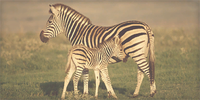





















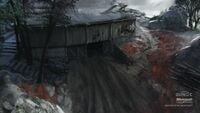














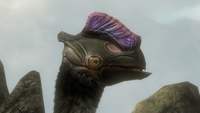
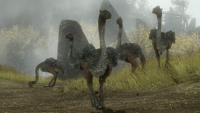


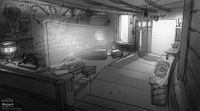



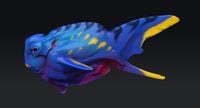






























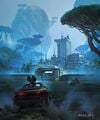




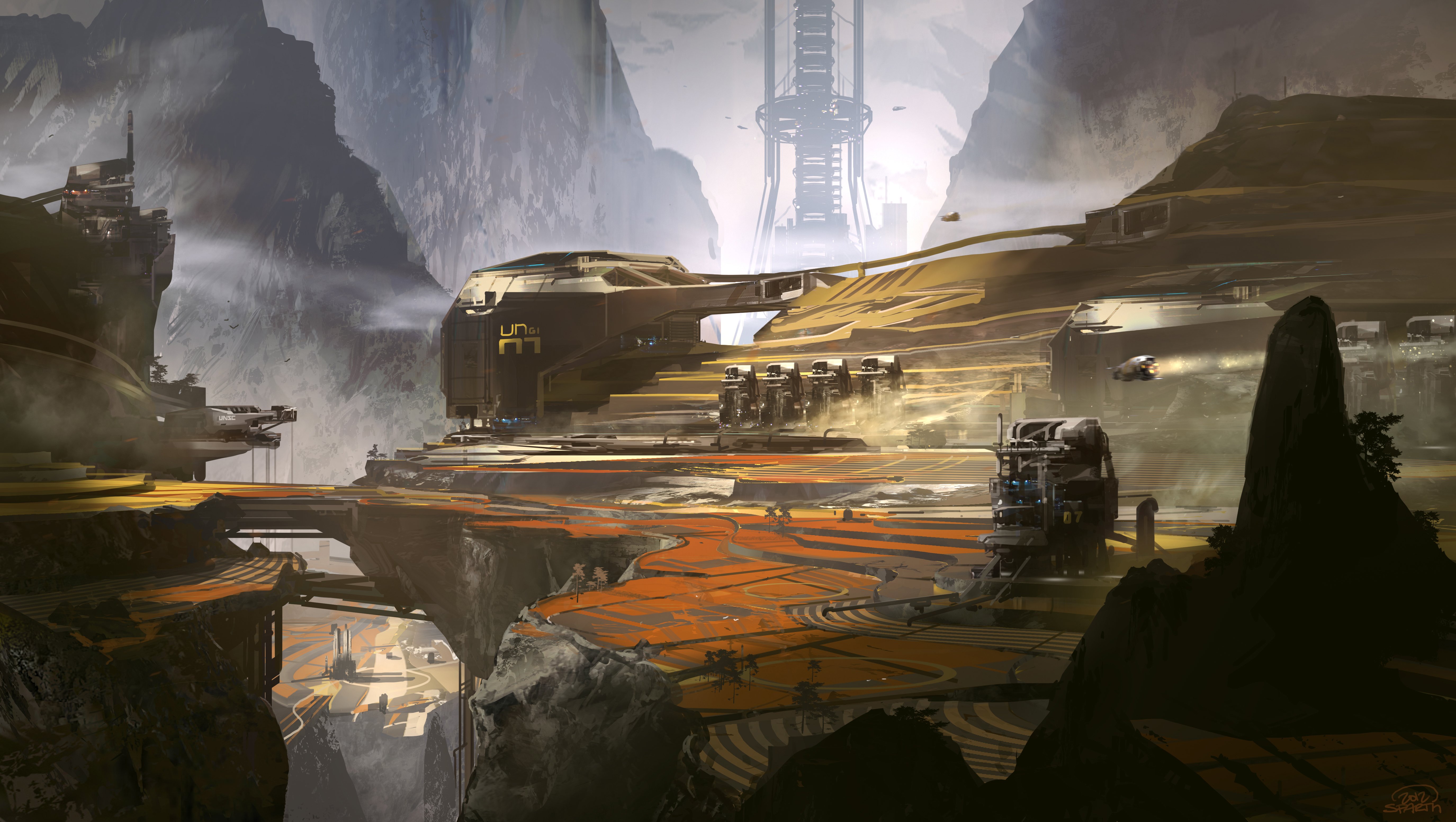











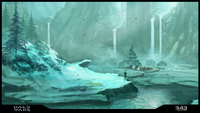













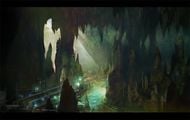
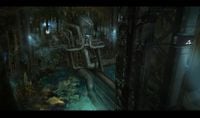





















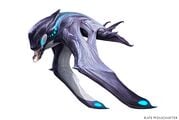
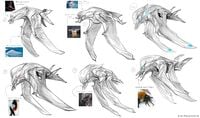






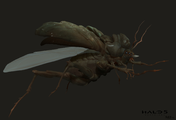













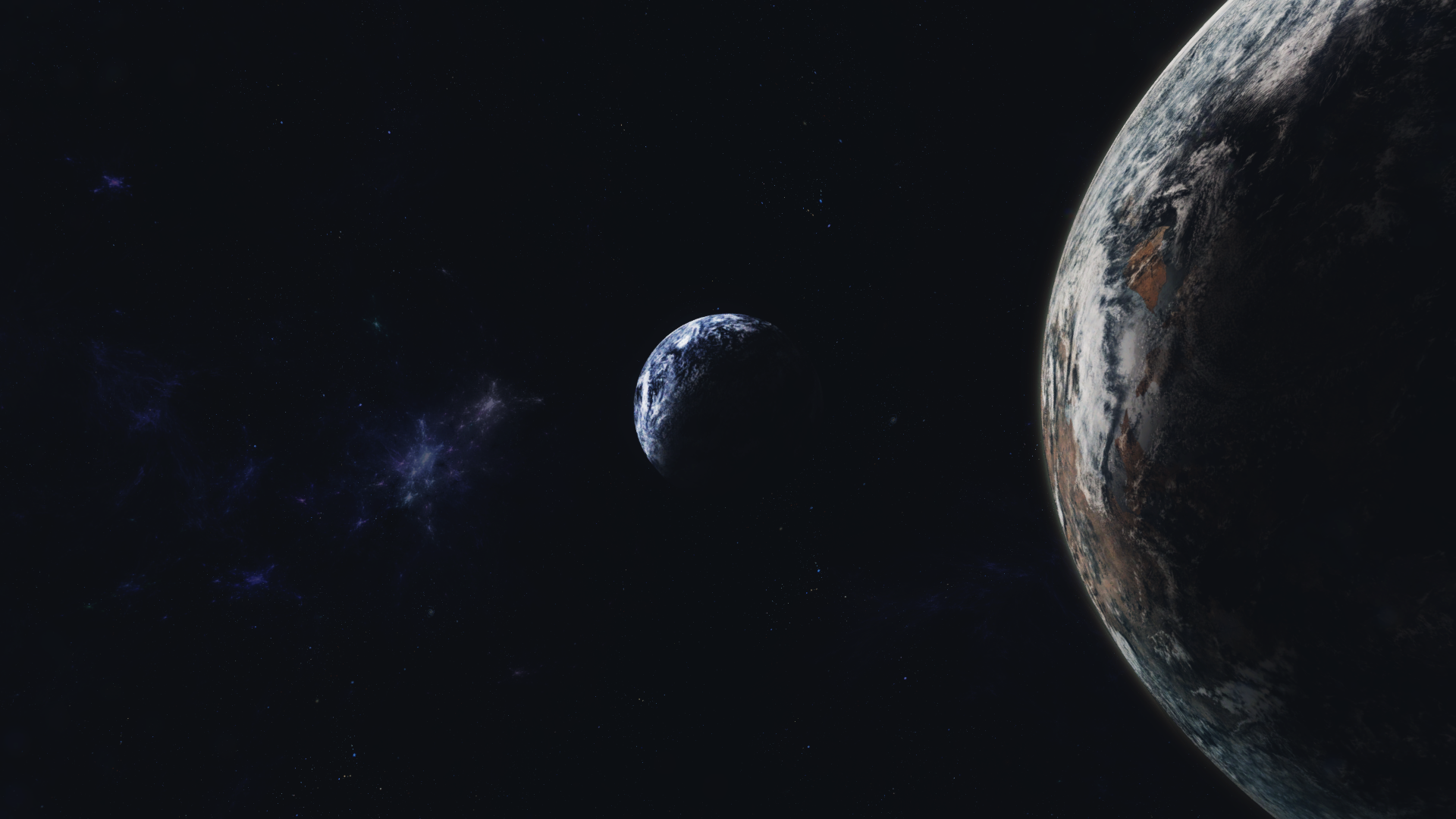








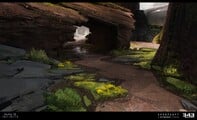

























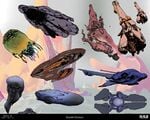




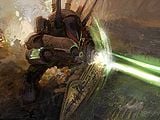
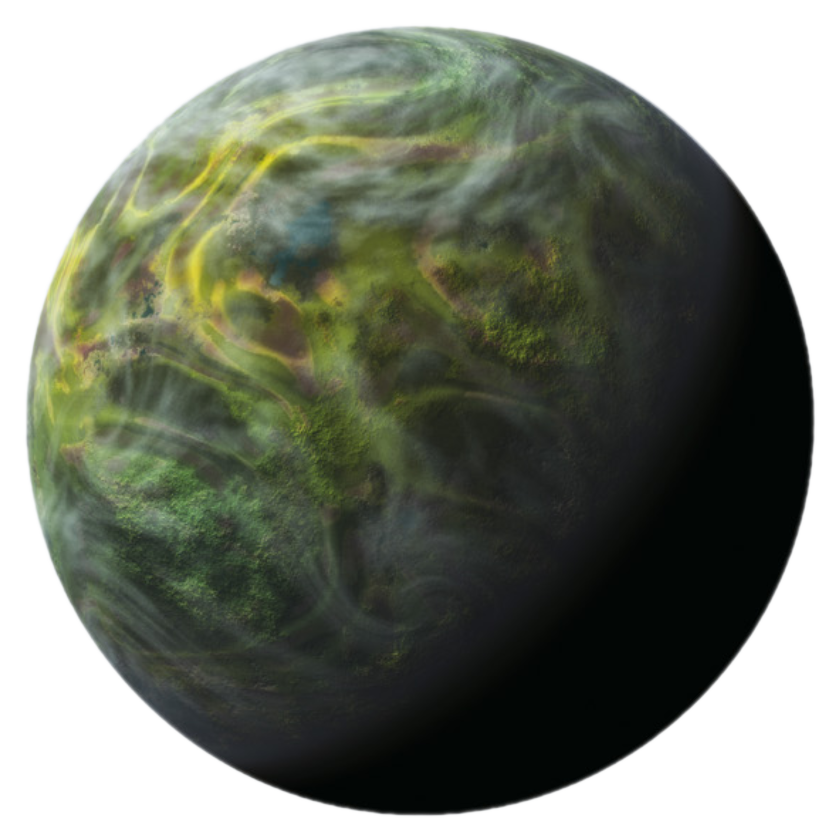

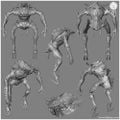





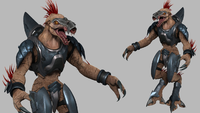












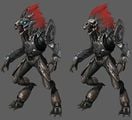















































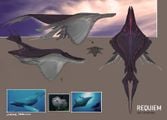




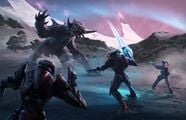















![Oxyaena - very similar to species of prehistoric fauna from Earth. [Note 5]](https://halo.wiki.gallery/images/thumb/a/a3/HW_Oxyaena_Render.jpg/113px-HW_Oxyaena_Render.jpg)


